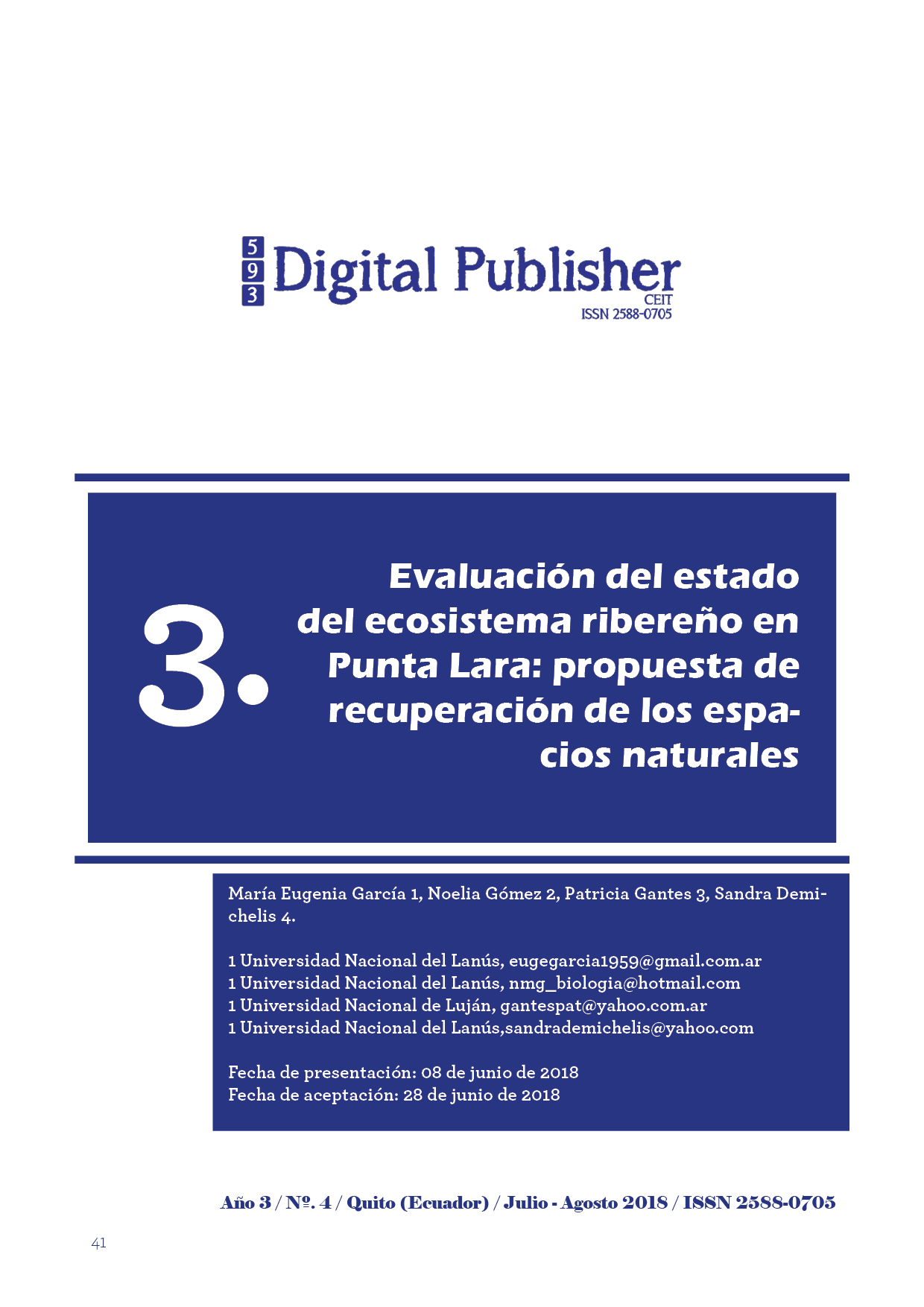Evaluación del estado del ecosistema ribereño en Punta Lara: propuesta de recuperación de los espacios naturales
Main Article Content
Abstract
The coastal ecosystems of the Río de la Plata are in a situation of increasing vulnerability. The advance of urbanization over natural spaces and the lack of adequate management have led to the loss of native species, the invasion of exotic species, the modification of spatial succession and the reduction, fragmentation and / or disappearance of these ecosystems and therefore to the loss of the services that they can provide. In this paper, the state of the natural spaces on the Punta Lara shore was characterized and evaluated. A temporary evolution evaluation of the natural riverside spaces was droven, including a description of the plant communities, the characterization of its ecological quality and surveys of the local population to know their perception and interests about the riparian space. Based on our results, a Management Proposal is presents in order to recover and preserve the riparian ecosystem.
Downloads
Article Details
1. Derechos de autor
Las obras que se publican en 593 Digital Publisher CEIT están sujetas a los siguientes términos:
1.1. 593 Digital Publisher CEIT, conserva los derechos patrimoniales (copyright) de las obras publicadas, favorece y permite la reutilización de las mismas bajo la licencia Licencia Creative Commons 4.0 de Reconocimiento-NoComercial-CompartirIgual 4.0, por lo cual se pueden copiar, usar, difundir, transmitir y exponer públicamente, siempre que:
1.1.a. Se cite la autoría y fuente original de su publicación (revista, editorial, URL).
1.1.b. No se usen para fines comerciales u onerosos.
1.1.c. Se mencione la existencia y especificaciones de esta licencia de uso.
References
Allan, D. 2004. Landscapes and Riverscapes: the in¬fluence of land use on stream ecosystems. Annual Review of Ecology, Evolution, and Systematics 35: 257-284.
Auble, G. T.; Friedman, J. M. Michael y L. Scott. 1994. Relating Riparian Vegetation to Present and Future Streamflows Ecological Applications 4 (3): 544-554.
Barbier, E.B., 2012. A spatial model of coastal ecosystem services. Ecological Economics 78 (2012) 70-79.
Cabrera, A. L. 1971. Fitogeografía de la República Argentina. Bol. Sociedad argentina de Botánica, 14, (1-2): 1-42.
Cabrera, A.L.; Dawson, G., 1994. La Selva Marginal de Punta Lara. Informe. Universidad Nacional de La Plata. 120 pp.
Cummins, K.W. 1974. Structure and function of stream ecosystems. BioScience 24:631-641.
Elosegi, A. & J. Díez. 2009. La vegetación terrestre asociada al río: el bosque de ribera. En: Conceptos y técnicas de Ecología Fluvial. ISBN: 978-84-96515-87-1.
Faggi, A.M., M. Arriaga y S. Aliscioni. 1999. Composición florística de las riberas del río Reconquista y sus alteraciones antrópicas. Rev. Museo Arg. Cs. Naturales 1(1): 1-6.
Fundación Torcuato Di Tella. (FTDT), informe final, 2005. Argentina: 2° Comunicación de Cambio Climático “vulnerabilidad de la zona costera”. 102 pp.
Gómez N.; Cochero, J., 2013. “Un índice para evaluar la calidad
del hábitat en la Franja Costera Sur del Río de la Plata y su vinculación con otros indicadores ambientales”. Instituto de Limnología Dr. R.A. Ringuelet, CONICET, CCT La Plata, Facultad de Ciencias Naturales y Museo (UNLP). Buenos Aires, Argentina.
Gómez, S.E., Torresani, N.I. 1999. Los Humedales de la Argentina. Clasificación, situación actual y legislación. Región 3: Pampas. Wetlands International Publication, Nº 46, 98-114.
INDEC, 2010. Datos poblacionales de la provincia de Buenos Aires.
Medan, D., Torretta, J.P, Hodara, K., de la Fuente, E.B., Montaldo, N.H., 2011. Effects of agriculture expansion and intensification on the vertebrate and invertebrate diversity in the Pampas of Argentina. Biodivers Conserv (2011) 20:3077–3100.
Medrano, D. and Demichelis S.O. 2011. Population risks in a small coastal town of the Rio de la Plata river: a case of study. Society for Risk Analysis 2011 Annual Meeting December 4-7.
Mendoza, R., I. García, L. de Cabo, C. Weigandt & A.F. de Iorio. 2015. The interaction of heavy metals and nutrients present in soil and native plants with arbuscular mycorrhizae on the riverside in the Matanza-Riachuelo River Basin (Argentina). Science of the Total Environment 505: 555–564.
Morello, J., Buzai, G.D., Baxendale, C.A., Matteucci, S.D., Rodríguez, A.F.; Godagnone, R.E., Casas, R.R. 2000. ”Urbanización y consumo de tierra fértil”, Revista Ciencia Hoy, Volumen 10, Nº 55, 50 – 61.
Naiman, R. J.; H. Décamps; M. E. McClain y G. E. Likens.2005. Riparia.Ecology, Conservation, and Management of Streamside Communities Elsevier.
Nilsson C, Svedmark M. 2002. Basic principles and ecological consequences of changing water regimes: riparian plant communities. Environ Manage 30:468–480.
Priano,M.E., 2007. Análisis ambiental Urbano del Partido de avellaneda. Trabajo Final. Universidad de Flores, Buenos Aires, 159 pp.
Quirós, R., Boveri, M.B., Petracchi, C.A., Rennella, A.M., Rosso, J.J., Sosnovsky, A., von Bernard, H.T. 2005. Los efectos de la agriculturización del humedal pampeano sobre la eutrofización de sus lagunas. En Eutrofizacao na America do Sul: causas, consequencias e tecnologías de gestao. Rede EUTROSUL, PROSUL, Sao Carlos, Brasil, second Draft., pp: 1- 15.
Troitiño, E. 2010. Trabajo final de aplicación, Ing. Agronómica, Universidad Nacional de Luján (UNLu). Tema: Evaluación de la conservación de las zonas ribereñas de arroyos pampeanos.
Velázquez, G.A. 2007. Geografía, fragmentación social y diferenciación territorial en la región pampeana. Hologramática. Fac. Cs. Sociales, UNLZ, año IV, pp. 49-70.
Viglizzo Ernesto F., Frank Federico C. 2006. Land-use options for Del Plata Basin in South America: Tradeoffs analysis based on ecosystem service provision. Ecological Economics 57 (2006) 140-151.

